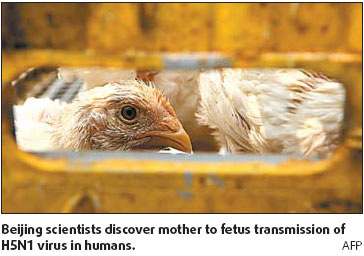Chinese researchers have discovered that the H5N1 strain of the bird flu virus can pass through the placenta of pregnant women to the unborn fetus and can infect organs other than the lungs in adults. The findings were published in the medical journal Lancet last month.
Professor Gu Jiang and colleagues of Peking University in Beijing studied post-mortem tissues of one man and one pregnant woman who were confirmed to have been infected by H5N1 virus when they were still alive.
They also tested the fetus of the dead woman. They investigated how the H5N1 virus, an emerging infectious disease that causes respiratory symptoms and a high fatality rate, affects different organs in the body.
"The transmission of the virus from mother to fetus has been established by our study. This is the first established report of human to human transmission as the fetus is a different individual from the mother," says Gu.
Little damage was found in the fetus examined by the researchers. However, any long-term problems or permanent damage to the fetus are not known at this time, according to Gu.
"The speculation about the fate of the fetus if the mother survived is interesting. With the development of antibodies in the mother and their transplacental crossing into the fetus, pathological lesions in the fetus may result," says Dr Wai Fu Ng of the Department of Pathology at Yan Chai Hospital in Hong Kong.
The major damage of H5N1 infection is still in the lungs as most patients died of respiratory failure, says Gu. However, so far, little is known about the specific effects in organs and cells targeted by the virus, which is an important question Gu and his colleagues tried to answer in their studies.
The researchers detected viral genetic material and antigens in the lungs, certain cells in the trachea, the T cells of the lymph node, and neurons in the brain. Viral genetic material was also detected in the intestinal mucosa, but no H5N1 viral antigens were found there.
"Our next goal in research is to ascertain the organs and cell types that can be infected by this new virus. In particular, we are not sure if bone marrow, thymus, and a number of other immune organs are infected," says Gu.
A major obstacle for their studies should be a lack of the tissue samples available for molecular investigation.
Up to now, owing to the difficulties to obtain complete autopsy of bird flu victims, only eight autopsies have been done worldwide and some of them were only partial autopsies, according to Gu. In particular, most of the studies did not perform molecular technique on the samples.
Funding is urgently needed for this and other studies on bird flu topic, according to Gu.
"Our group at Peking University have obtained many very important results in the research of bird flu and SARS with very limited funding. Our results have been published in a number of important international journals that has established China's strong position in the field of pathology and pathogenesis of research of newly emerged infectious diseases," he says.
(China Daily October 10, 2007)


